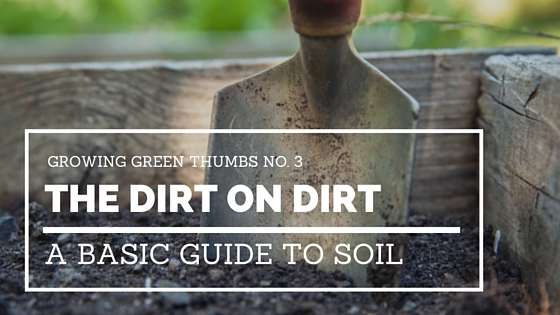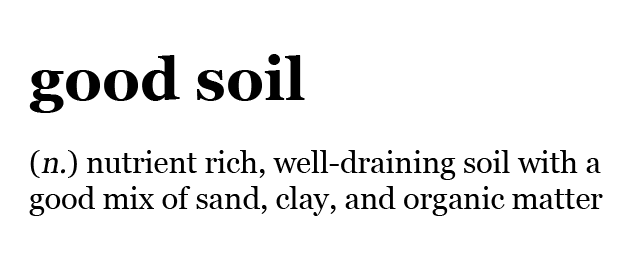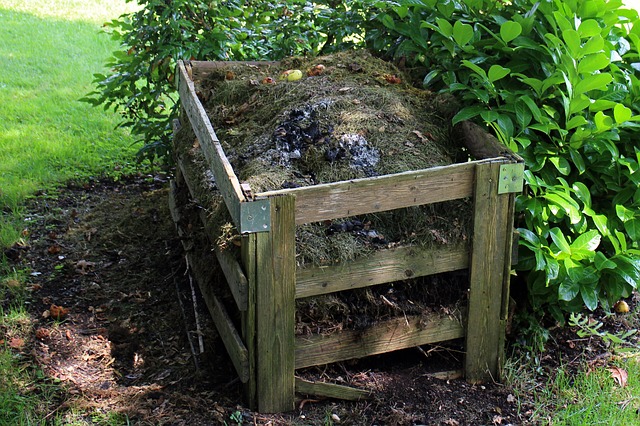
Soil provides the foundation for a plant’s vitality. Even if you provide your plants with the best of the best, like planting it in diamond encrusted containers or watering with bottles of Fengari Platinum, without good soil your plants will never reach their full potential. Kind of like the 40 year-old Harvard-educated, unemployed bachelor living in his parents’ basement.
Ultimately, it all starts with the good soil.

Do you have good soil? Well, the easiest (and possibly best) way to answer that is to have an expert take a look. You can bring a jar of soil (or several from different parts of your garden) into your local garden centre/nursery to see what you’re working with. The knowledgeable staff will lead you in the right direction with regards to improvements you can make too!
Alternatively, if you are feeling like an unstoppable force that won’t let anything stand in your way (aka Leslie Knope), you can examine your own soil. Full disclosure, I am not an expert when it comes down to the nitty gritty, science-ness of soil. So if you need to know that kind of stuff, you’ll have to do your own digging elsewhere. Let’s just go with the basics.
Types of Soil
Soil type mostly refers to the texture and physical properties of the soil, like nutrient retention and water drainage. There are three main types:
- Clay: heavy and sticky type of soil. Tends to hold nutrients well but is slow draining. This may cause problems with root rot. — Not Ideal
- Sandy: very light and porous type of soil. Very quick to drain but has difficulty holding onto water and nutrients. — Not Ideal
- Loam: the ideal type of soil. It retains nutrients and moisture well but also drains well. Most plants favour this type of soil.
To test your soil type:
- Squeeze Test: helps to determine the type of soil you have
- Take a handful of moist soil and firmly squeeze. When you open your hand, the soil will either
- Hold its shape and crumble after being lightly poked à Loam
- Hold its shape but does not crumble after being poked à Clay
- Falls apart faster than you can say Jack Robinson à Sand
- Percolation Test: helps to determine the draining capabilities of the soil
- Dig a hole roughly 1 inch deep and 6 inches wide
- Fill the hole with water then allow it to drain completely
- Fill the hole again with water
- Monitor the time it takes for the water to completely drain
- If it takes longer than 4 hours to drain, you have poor drainage
Soil Acidity
Okay, I know I said that I wouldn’t get into the science –y stuff but this is important. If you remember from high school chemistry class, pH is the measure of acidity/alkalinity. In the most basic explanation I can think of, soil pH relates to the amount of key nutrients that are available for your growing plants. Or something along those lines. Like I said, I’m not great with the science. Acidic soil has a pH between 1.0 and 6.9; basic soil has a pH between 7.1 and 14. Most plants prefer nearly neutral soils with pH between 6.2 and 7.2.
Testing kits are available at any garden centre or nursery and will produce pretty reliable results. Or, if you’re really hardcore, you can send it to special soil labs for extensive testing. Acidic soil is corrected by adding lime or ground limestone to the soil at planting time. Lowering the pH of alkaline soil is not practical, but knowing that the soil is alkaline may mean that you need to apply more fertilizer.
The Magic Fix

Whether you want to improve your soil structure (i.e. change your soil type) or lower pH, the key ingredient is compost. Some suggestions for organic matter for your compost:
- Shredded leaves
- Grass clippings
- Dead garden plants
- Remains of vegetable plants after harvest
- Pulled weeds (not gone to seed)
- Vegetable trimmings
- Coffee grounds
- Tea leaves
- Fruit and vegetable scraps
- Newspaper
- Chopped straw or hay
Do NOT compost the following:
- Weeds with roots
- Weeds that have flowered or set seed
- Cooked food, bread, meat or food with oil-based dressing
- Pet waste
- Diseased or insect-infested plant materials
Well, that’s it. That’s the super basic dirt on dirt.
